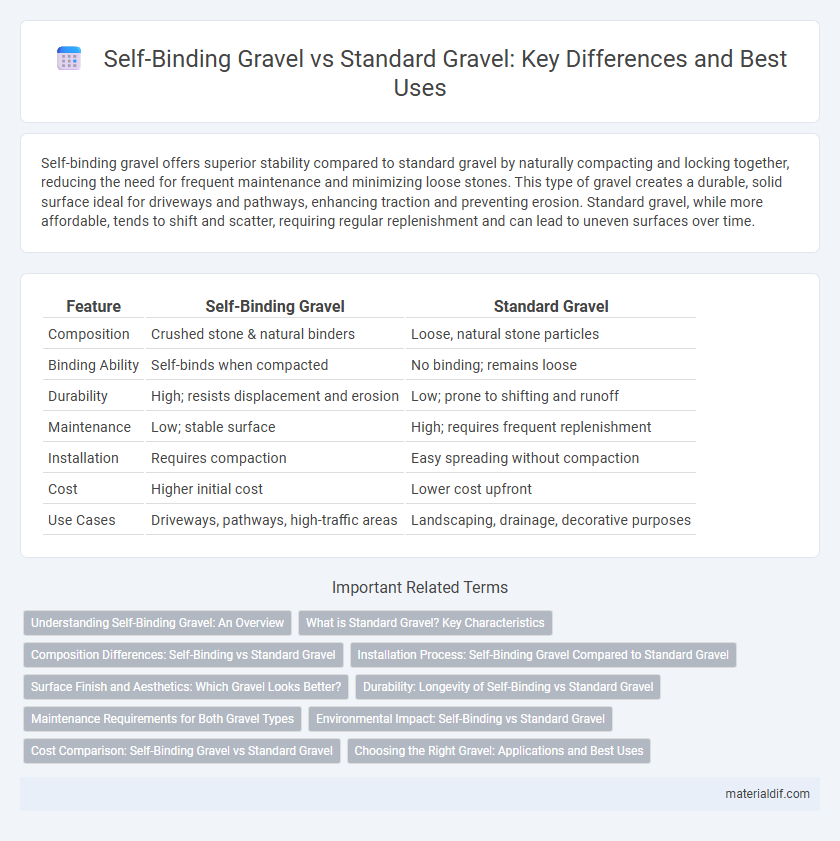Self-binding gravel offers superior stability compared to standard gravel by naturally compacting and locking together, reducing the need for frequent maintenance and minimizing loose stones. This type of gravel creates a durable, solid surface ideal for driveways and pathways, enhancing traction and preventing erosion. Standard gravel, while more affordable, tends to shift and scatter, requiring regular replenishment and can lead to uneven surfaces over time.
Table of Comparison
| Feature | Self-Binding Gravel | Standard Gravel |
|---|---|---|
| Composition | Crushed stone & natural binders | Loose, natural stone particles |
| Binding Ability | Self-binds when compacted | No binding; remains loose |
| Durability | High; resists displacement and erosion | Low; prone to shifting and runoff |
| Maintenance | Low; stable surface | High; requires frequent replenishment |
| Installation | Requires compaction | Easy spreading without compaction |
| Cost | Higher initial cost | Lower cost upfront |
| Use Cases | Driveways, pathways, high-traffic areas | Landscaping, drainage, decorative purposes |
Understanding Self-Binding Gravel: An Overview
Self-binding gravel consists of crushed stone mixed with fine dust particles that harden when compacted, creating a firm, durable surface ideal for paths and driveways. Unlike standard gravel, which requires regular maintenance to keep the stones in place, self-binding gravel forms a stabilized layer that minimizes displacement and reduces erosion. This material's natural binding properties enhance load-bearing capacity and provide excellent drainage, making it a practical choice for landscaping and construction projects.
What is Standard Gravel? Key Characteristics
Standard gravel consists of naturally occurring rock fragments typically measuring between 2mm and 64mm, commonly used in construction and landscaping. It lacks any adhesive properties, resulting in loose, easily shifted particles that require compaction or binding agents for stability. Its key characteristics include well-drained, non-cohesive material, varying in color and composition depending on the source rock, making it versatile but less stable than self-binding varieties.
Composition Differences: Self-Binding vs Standard Gravel
Self-binding gravel contains a higher proportion of fine particles, such as clay and crushed stone dust, which act as natural binders to create a solid, compact surface when compacted. Standard gravel primarily consists of coarse, rounded stones with minimal fines, resulting in a looser surface that requires additional stabilizing materials or binders. The increased fines content in self-binding gravel enhances durability and reduces loose debris, making it suitable for pathways and driveways requiring firm, erosion-resistant surfaces.
Installation Process: Self-Binding Gravel Compared to Standard Gravel
Self-binding gravel requires a more precise installation process involving a compacted sub-base and careful spreading to activate its binding properties, resulting in a stable and durable surface. Standard gravel installation is simpler, generally requiring only spreading and leveling over a prepared base without the need for compacting a binding agent. Self-binding gravel reduces maintenance efforts by minimizing loose stones and erosion compared to traditional loose gravel surfaces.
Surface Finish and Aesthetics: Which Gravel Looks Better?
Self-binding gravel offers a smoother, more uniform surface finish that enhances aesthetics with fewer loose stones and reduced dust compared to standard gravel. Standard gravel provides a more natural, rustic appearance with visible loose stones and varied textures, appealing to those seeking a less polished look. For projects prioritizing clean, cohesive surfaces, self-binding gravel typically looks more refined, while standard gravel suits designs favoring organic and rugged visual appeal.
Durability: Longevity of Self-Binding vs Standard Gravel
Self-binding gravel offers enhanced durability due to its natural adhesive properties, creating a more stable and long-lasting surface compared to standard gravel, which tends to disperse and require frequent replenishing. Its interlocking particles resist erosion and reduce displacement under heavy usage, significantly extending its lifespan. Standard gravel, lacking these binding agents, generally deteriorates faster, leading to increased maintenance and replacement costs over time.
Maintenance Requirements for Both Gravel Types
Self-binding gravel requires less frequent maintenance due to its natural adhesive properties that help it compact and resist displacement, minimizing the need for regular re-leveling or replenishment. Standard gravel tends to shift and scatter over time, necessitating more frequent raking, topping up, and weed control to maintain a stable, even surface. Proper installation and occasional grading enhance longevity for both types but self-binding gravel generally offers superior durability and reduced upkeep demands.
Environmental Impact: Self-Binding vs Standard Gravel
Self-binding gravel reduces environmental impact by minimizing the need for chemical binders and extensive maintenance, lowering runoff and soil erosion compared to standard gravel. Its natural cohesion improves water permeability, decreasing surface water pollution and promoting groundwater recharge. Standard gravel often requires regular replenishment and can contribute to dust pollution and sediment displacement, increasing environmental strain.
Cost Comparison: Self-Binding Gravel vs Standard Gravel
Self-binding gravel generally costs more per ton compared to standard gravel due to the inclusion of fine particles or additives that help bind the stones together. While standard gravel prices range from $10 to $50 per ton depending on type and region, self-binding gravel can cost between $50 and $100 per ton because of its enhanced durability and reduced maintenance requirements. The higher upfront investment in self-binding gravel often leads to long-term savings by minimizing road repairs and erosion control expenses.
Choosing the Right Gravel: Applications and Best Uses
Self-binding gravel offers superior stability and erosion resistance, making it ideal for driveways, pathways, and low-traffic areas where a smooth, durable surface is desired. Standard gravel, composed of loose aggregate, is better suited for drainage applications, base layers in construction, and landscaping projects requiring flexibility and easy movement. Selecting the right gravel depends on factors such as load-bearing requirements, environmental conditions, and maintenance preferences to ensure optimal performance and longevity.
Self-Binding Gravel vs Standard Gravel Infographic

 materialdif.com
materialdif.com